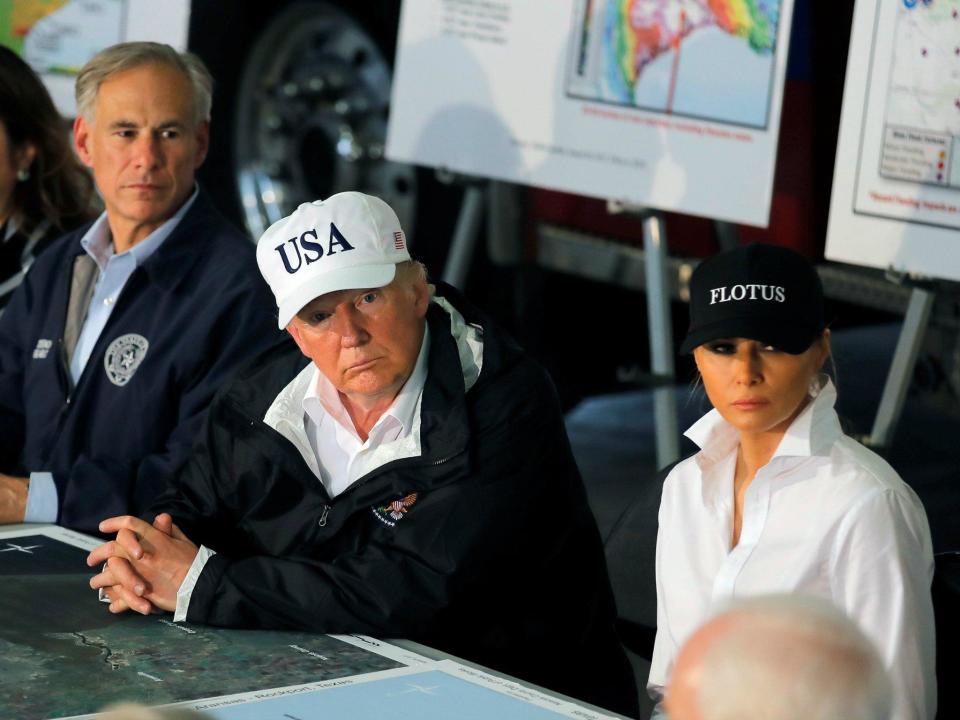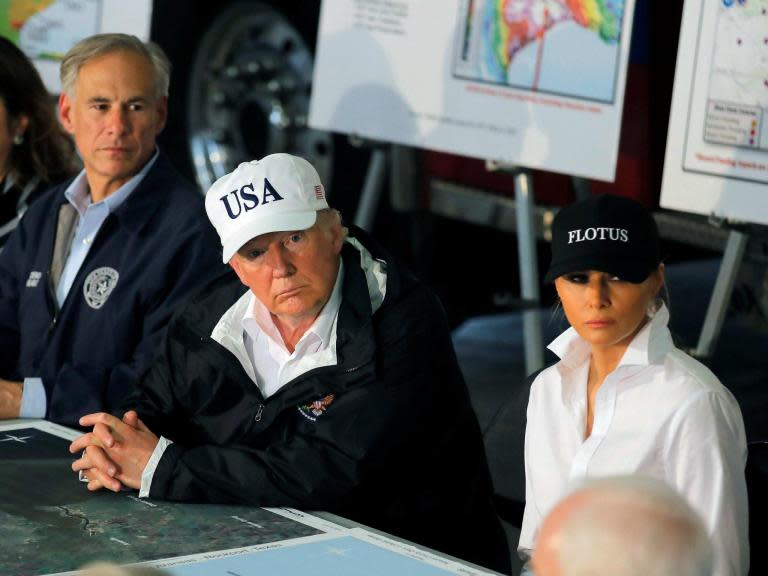Trump arrives in Texas to reassure Harvey victims and marvel at crowd sizes
Donald Trump touched down in Texas to survey the damage caused by Hurricane Harvey knowing that it involved a difficult political balancing act: don’t appear and potentially suffer the same barrage of criticism George W Bush faced in the wake of hurricane Katrina, do appear and risking affecting rescue efforts with rain still set to hammer the area for another two days.
Mr Trump was quick to praise the efforts of those on the ground during a visit to the town of Corpus Christi – one of the cities near the coast that faced the brunt of Harvey – while later visiting Austin. The presidential entourage avoided Houston and the surrounding area, where the vast majority of the more than 17,000 who had sought shelter were gathered, with the White House keen to stress that Mr Trump wanted to be “very cautious” not disrupt recovery efforts.
Meeting officials in Corpus Christi Mr Trump wore a white “USA” cap, with his surname emblazoned on the back – it is available on his website for $40. Accompanying her husband, Melania Trump’s matching cap was emblazoned with the word “Flotus” in upper case – First Lady of the United States. At a briefing, Mr Trump made clear he wanted his response to set an example.
“We want to do it better than ever before,” he said. “We want to be looked at in five years, in 10 years from now as, this is the way to do it. This was of epic proportion”.
The President added: “Nobody's ever seen anything like this and I just want to say that working with the governor [Texas Governor Greg Abbott] and his entire team has been an honour for us”.
Governor Abbott was, in turn, effusive in his praise for Mr Trump and his response, saying he had been in contact with the White House for the past two weeks.
Mr Trump later met a crowd outside a local fire station. “Thank you” he said to applause, “we love you, you are special, we are here to take care of you,” he said. “It’s going well.”
“What a crowd, what a turnout,” he called out to the hundreds of people gathered, although there appeared no expression of sympathy for victims of the storm.
Elsewhere, more than 3,500 rescues had taken place across Houston by Tuesday afternoon, with rising water still a major issue. The US record for rainfall from a tropical storm system was broken at the Mary’s Creek weather station, reaching 49.32 inches. The record had stood since 1978, and with further rain – up to 12 more inches in certain parts of the Texas coast – expected, officials are preparing for further problems.
At least 15 deaths have been reported, the latest being a policeman driving to work in Houston, while two major dams in the area are either overspilling or close to it. Some of the water from the reservoirs around the dams has had to be vented, flooding neighbouring areas, an unavoidable problem for local officials.
Mr Trump’s visit poses its own potential problems. Law enforcement, medical and other emergency officials are often wary of diverting critical resources to presidential security and logistics while major relief operations are still underway. Presidential visits require ordering hospitals on standby, closing air space and supplementing federal security detail with state and local officers. Some critics had called for the visit to be delayed a few days.
However, it is clear that Mr Trump and his White House staff are wary that he is facing his first major natural disaster and that delaying could mean not coming for months. Mr Bush’s administration never really recovered from the fallout from the devastation of Katrina, the storm that hit New Orleans in 2005. Critics said the rescue effort was bungled. Mr Bush took a plane over the area, so not to affect rescue efforts, and was pilloried.
Criticism of the Trump’s had started before they even boarded Marine One from the White House. A number of articles appeared criticising the First Lady’s choice of footwear she appeared wearing black stilettos. Ms Trump's communications director was quick to respond, hitting out at members of the media for being “worried about her shoes” during an “active and ongoing natural disaster”. By the time Ms Trump appeared on the ground in Texas, she was wearing white tennis shoes.
Beyond the circus of the President’s visit, with more than 30,000 people expected to require emergency shelter after Harvey, authorities in Houston are scrambling to provide sufficient facilities: accommodation, clean clothes, food and safety.
The George R Brown Convention Centre, which had been designated the initial dropping-off point, now houses more than 9,000 people and Houston Mayor Sylvester Turner said his office had asked the Federal Emergency Management Agency for assets to allow the city to shelter another 10,000 people.
Other shelters were set up in Dallas, about 250 miles (402 km) to the north, for about 8,000 people, and Austin, 160 miles (258 km) west, to take in 7,000 people.
Karen Haughton said she had been in the convention centre since 11pm on Sunday, after she was rescued from her home as the water reached three feet and was still rising.
“I had neighbours who had a big boat and they were saving people and as they came past me,” she said. “I shouted to them, and they said they’d come back and get me, and they did,” Ms Haughton added.
She said she had been anxious about going to the convention centre – memories of the horrors that took place inside New Orlean’s Superdome following Hurricane Katrina, are imprinted in the collective memory. Yet she said the facilities she had found were excellent, given the circumstances. “I’ve no complaints,” she said.
Marcia Chrane was forced to take shelter there after travelling from Dallas to Houston for a Coldplay concert and getting stranded after bus company Greyhound stopped its service. “Things are OK. I am going to be stuck here until the buses start again,” she said.
Kimberley Sowell was part of a group of three with her son and partner. They had only just arrived. Two hours earlier they had been brought in after being rescued from their apartment in the east of the city. She said the water had destroyed their home, and they had been forced to move into the house of a neighbour.
She said their home was destroyed but was pleased that nobody was hurt. “We’ve not been able to sleep for two days.”
Michael Albert was part of a group of around 40 people made up of seven families who had rescued themselves using two school buses. “The houses got full and we moved to a school. Then we came here,” said the 30-year-old.
Stephanie Mata was nursing a four-month-old baby, Aurora. “It started on Friday. To start with we wanted to stay but then we decided to get out of there because of her,” she said.
There will be many stories like these in the days to come, with storm set to hit Louisiana on Wednesday, a day after the 12th anniversary of Hurricane Katrina which killed more than 1,800 people across the state. The National Guard is responding by potentially increasing the number of troops on the ground fivefold, with potentially up to 20,000 to 30,000 troops coming in from other states.
But the question over preparedness will linger. When senior National Guard official James Witham was asked whether Texas authorities recognised the magnitude of the disaster quickly enough, major-general Witham said: “That's debatable.” He added in some respects the need was recognised quickly. But the extraordinary amount of rainfall and flooding exceeded what state planners could have foreseen.
“So if you're looking at an event that only occurs every few hundred years, the planning that would have normally occurred for that probably wasn't here,” he said. “In many cases, the request for assistance, not only for the National Guard but federal forces, may not have been anticipated quickly enough.”


